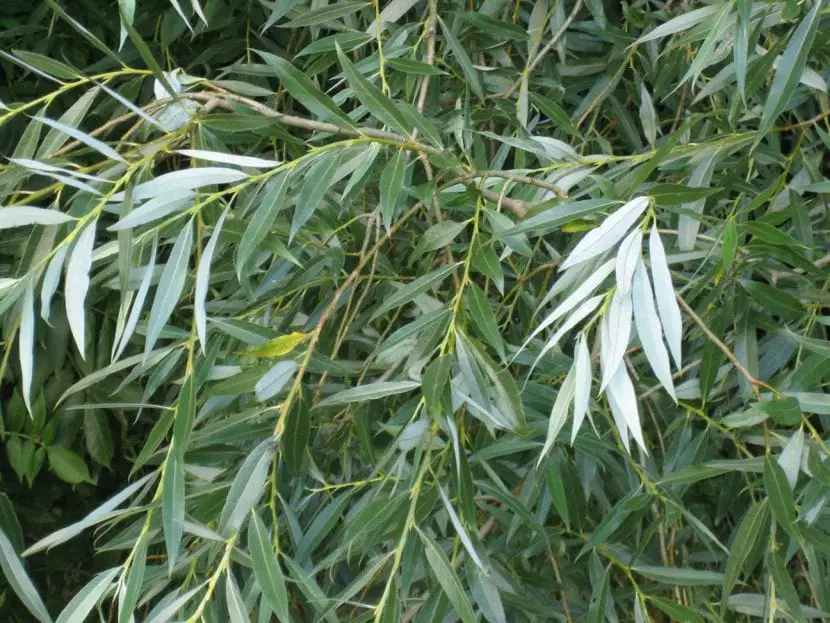
If you have a large field and in your area there are no major frosts, we recommend having the beautiful tree whose scientific name is Salix alba. It is very similar to weeping willow (Babylonian willow), but our protagonist does not need as much humidity or as much maintenance as his cousin-brother.
In addition, there are some varieties that have a “weeping” bearing, so you can be well protected from the sun under the shade of its branches.
Features Salix alba

White Willow ‘Sad’
This is a deciduous tree that grows in the temperate regions of central and southern Europe, North Africa, and West Asia. It can also be found in North America. It is known by the names of salguero, white willow or silver willow, since the underside of its leaves is silver gray very striking. These are lanceolate in shape, with serrated edges and 6-12cm in length. Its flowers, which sprout in spring, have catkins with a cylindrical shape. The fruit is an ovoid capsule.
The tree is robust, rounded and well proportioned. It can reach 25 meters in height and have a 5-6m glass. It is important to add that the young branches are reddish, which gives them a much more ornamental appearance if possible.
How do you take care of yourself?

If you want to have a White Willow in your garden, here is its care guide:
Location
Being a fairly large tree must be placed outside in full sunat a minimum distance of 10 meters from other tall plants and from pipes and / or soil, since their roots could destroy them.
Land
The White Willow grows on all types of soilsincluding those of the limestone type with poor drainage so you won’t have to worry about this .
Irrigation
Being a plant that normally lives near water courses, irrigation it has to be frequent. At a minimum, you have to receive the precious liquid 3-4 times a week during the hot months, and 2-3 / week the rest of the year. Try to prevent the soil from drying out completely.
Subscriber
From early spring to late summer / early fall it is advisable to pay it with organic fertilizershow can he be bat guano. In this way, you can have a better development.
Planting time
The time to definitely plant it in the garden is in springwhen the risk of frost has passed and the minimum temperature is 15 degrees Celsius or more.
Diseases
The salguero have two diseases:
- Anthracnose: it is caused by fungi of the genus Gloeosporium or Colletotrichum. Small spots appear on the leaves that end up increasing in size and necrotizing. It deals with Copper oxychloride.
- Watermark: caused by bacteria Brenner willow. This microorganism causes the death of branches and leaves. There is no known treatment that is really effective, with the exception of the preventive one that consists of keeping the tree well watered and fertilized in order for its health to be good.
Multiplication
Cuttings
Cuttings are obtained in autumn and winter, when it no longer has leaves. For it, Several healthy 1-year-old branches are chosen that are the thickness of a pencil, and from these, pieces of about 30cm in length are made.
Now, with a cuttex remove a little bark from the base, leaving about 3cm without it. Then it will only be left to moisten the base and impregnating it with rooting hormones in order to root as soon as possible.
Finally, plant them in pots with porous substrate (It can be 100% perlite, or if you prefer, mix it with black peat in equal parts), give them a good watering and place them in a corner where they are not directly exposed to sunlight, outside.
If all goes well, they will take root in a month or two at the most.
Seeds (difficult)
They have to seed with vermiculite in direct sun during spring. The germination time is variable, and can be from 10 days to 2 months.
Rusticity
The Silver Willow is a very hardy tree capable of withstanding frosts of up to -20ºC with hardly any damage.
What uses does the Salix alba or White Willow?

Garden plant
It is a very beautiful tree that looks great in any large garden. Gives very good shade and, as we have seen, except for two diseases it is very resistant. It is, without a doubt, a good excuse to be outdoors even during the hottest time of the year.
To make useful things
- Young branches are used in basketry.
- Its wood, being very light, is used to make rafters, roofs, toothpicks, matchesetc.
Medicinal
An interesting use that you may have heard of is medicinal. From its bark the salicinwhich is the origin of acetylsalicylic acid, which is much better known by the name of aspirin. Yes, yes, the typical pill we take when we start to feel a little cold.
Silver willow is used as analgesic, anti-inflammatory, antipyretic, anticoagulant, tranquilizer, astringent and depurative. This means that it is one of the most complete medicinal plants out there. So if you have any of the problems that we are going to tell you below, you can take it as a natural remedy to relieve symptoms: flu, cold, muscle pain, fibromyalgia, earache, rheumatic pain, insomnia, diarrhea, heartburn, sciatica, wounds or burns.
It can be taken in the following ways:
- Infusion: 20g of young leaves in 1l of water, three cups a day.
- Decoction: 40g of dry bark per liter of water, three cups a day.
Contraindications
You should not take White Willow if you have allergy to aspirin or medications with the same principle (acetylsalicylic acid), heartburn, gastric ulcer, intestinal bleeding, asthma, kidney or liver problems, colitis or hemophilia. Likewise, it should not be taken in combination with anticoagulant or anti-inflammatory medications, or during pregnancy.
When in doubt, always consult your doctor.
What did you think of this plant?
